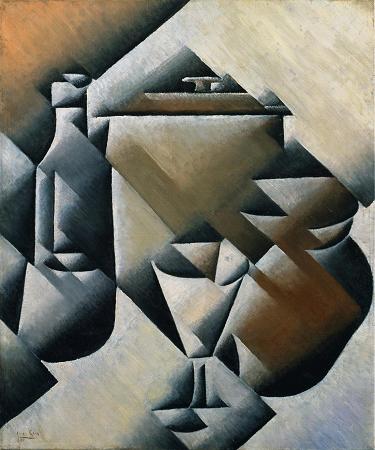Juan Gris (1887 - 1927). José Victoriano González-Pérez, better known as Juan Gris, was a Spanish painter born in Madrid who lived and worked in France most of his life. Closely connected to the innovative artistic genre Cubism, his works are among the movement's most distinctive. Gris was born in Madrid and later studied engineering at the Madrid School of Arts and Sciences. There, from 1902 to 1904, he contributed drawings to local periodicals. From 1904 to 1905, he studied painting with the academic artist José Moreno Carbonero. It was in 1905 that José Victoriano González adopted the more distinctive name Juan Gris. In 1909 Lucie Belin, Gris' first wife, gave birth to Georges Gonzalez-Gris, the artists only child. The three lived at the Bateau-Lavoir, 13 Rue Ravignan, Paris, from 1909 to 1911. In 1912 Gris met Charlotte Augusta Fernande Herpin, also known as Josette. Late 1913 or early 1914 they lived together at the Bateau-Lavoir until 1922. Josette Gris was Juan Gris' second companion and unofficial wife. In 1906 he moved to Paris and became friends with the poets Guillaume Apollinaire, Max Jacob, and artists Henri Matisse, Georges Braque, Fernand Léger and Jean Metzinger. He submitted darkly humorous illustrations to journals such as the anarchist satirical magazine L'Assiette au Beurre, and also Le Rire, Le Charivari, and Le Cri de Paris. In Paris, Gris followed the lead of Metzinger and another friend and fellow countryman, Pablo Picasso. Gris began to paint seriously in 1911, developing at this time a personal Cubist style. In A Life of Picasso, John Richardson writes that Jean Metzinger's 1911 work, Le goûter, persuaded Juan Gris of the importance of mathematics in painting. Gris exhibited for the first time at the 1912 Salon des Indépendants. He appears with two styles, writes art historian Peter Brooke, In one of them a grid structure appears that is clearly reminiscent of the Goûter and of Metzinger's later work in 1912. In the other, Brooke continues, the grid is still present but the lines are not stated and their continuity is broken. Their presence is suggested by the heavy, often triangular, shading of the angles between them. Both styles are distinguished from the work of Picasso and Braque by their clear, rational and measurable quality. Although Gris regarded Picasso as a teacher, Gertrude Stein wrote in The Autobiography of Alice B. Toklas that Juan Gris was the only person whom Picasso wished away. In 1912 Gris exhibited at the Exposicío d'art cubista, Galeries Dalmau in Barcelona, the first declared group exhibition of Cubism worldwide; the gallery Der Sturm in Berlin; the Salon de la Société Normande de Peinture Moderne in Rouen; and the Salon de la Section d'Or in Paris. Gris, in that same year, signed a contract that gave Daniel-Henry Kahnweiler exclusive rights to his work. At first Gris painted in the style of Analytical Cubism, a term he himself later coined, but after 1913 he began his conversion to Synthetic Cubism, of which he became a steadfast interpreter, with extensive use of papier collé or, collage. Unlike Picasso and Braque, whose Cubist works were practically monochromatic, Gris painted with bright harmonious colors in daring, novel combinations in the manner of his friend Matisse. Gris exhibited with the painters of the Puteaux Group in the Salon de la Section d'Or in 1912. His preference for clarity and order influenced the Purist style of Amédée Ozenfant and Charles Edouard Jeanneret, and made Gris an important exemplar of the post-war return to order movement. In 1915 he was painted by his friend, Amedeo Modigliani. In November 1917 he made one of his few sculptures, the polychrome plaster Harlequin. Main article: Crystal Cubism Gris's works from late 1916 through 1917 exhibit a greater simplification of geometric structure, a blurring of the distinction between objects and setting, between subject matter and background. The oblique overlapping planar constructions, tending away from equilibrium, can best be seen in Woman with Mandolin, after Corot and in its epilogue, Portrait of Josette Gris. The clear-cut underlying geometric framework of these works seemingly controls the finer elements of the compositions; the constituent components, including the small planes of the faces, become part of the unified whole. Though Gris certainly had planned the representation of his chosen subject matter, the abstract armature serves as the starting point. The geometric structure of Juan Gris's Crystal period is already palpable in Still Life before an Open Window, Place Ravignan.
more...













